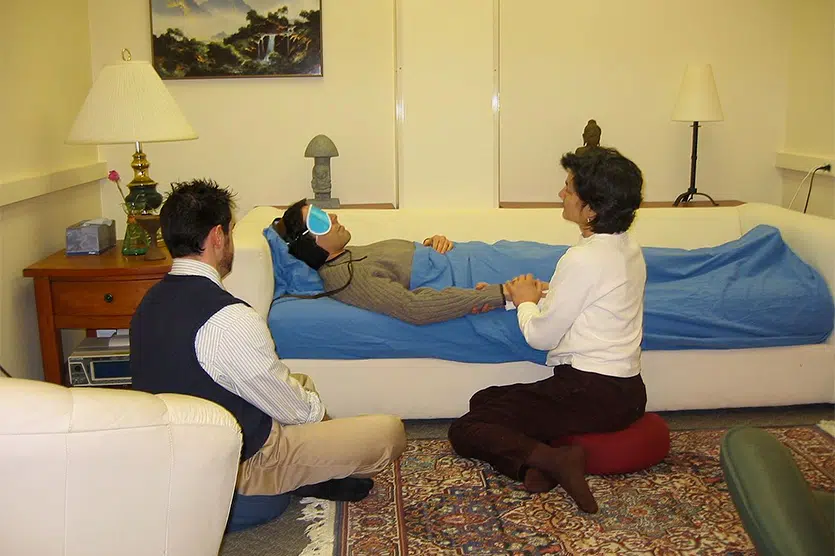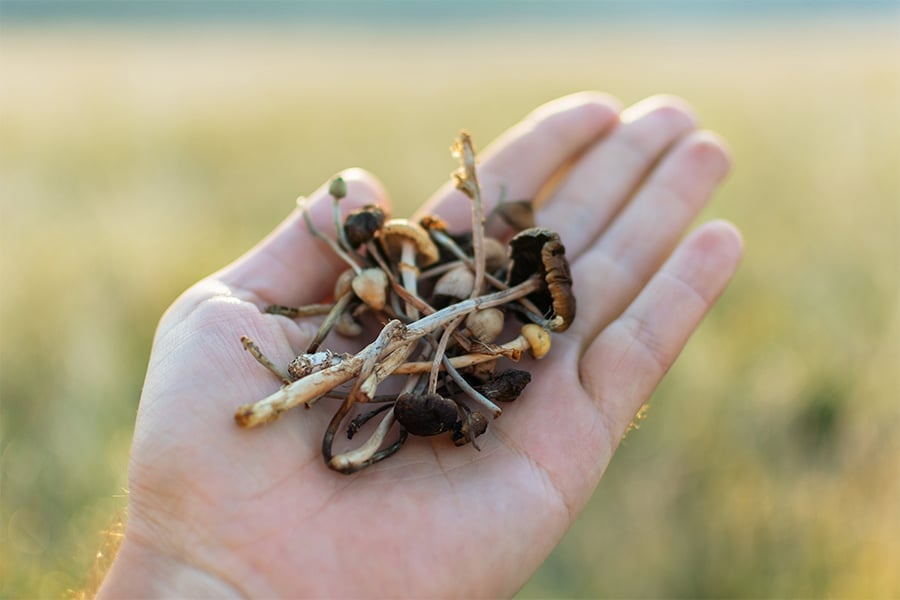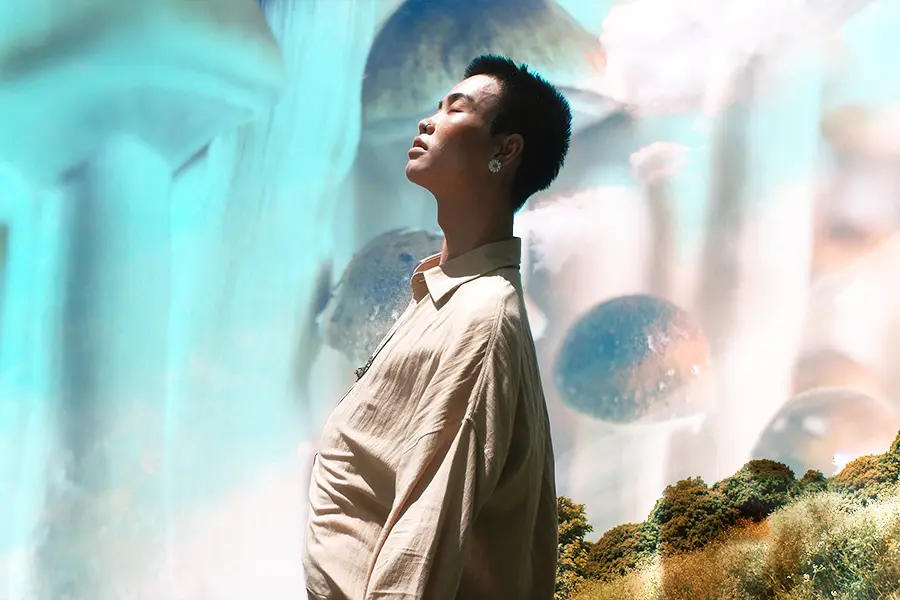Over half a century has passed since the last heyday of psychedelic research. During the 50s and 60s, the therapeutic potential of psychedelics, like psilocybin, dazzled researchers and inspired hopeful psychonauts throughout the Western world. Now, a resurgence of research has once again fanned the prospect of psilocybin therapy—but will our society be responsible enough this time around?
Dr. Charles Grob certainly hopes so—and if there’s anyone who can explain the promise and pitfalls of psilocybin therapy, it’s Dr. Grob. His resume is impressive: Grob is a psychedelic researcher, professor of psychiatry and pediatrics at the UCLA School of Medicine, and co-founder of the Heffter Research Institute, which promotes the scientific research of psilocybin and other psychedelic compounds.
Emerging research suggests that psilocybin therapy may have therapeutic potential for various mental health conditions, including substance use disorder, treatment-resistant depression, and other psychological conditions that are historically difficult to treat with conventional therapy and medications. But, how does psilocybin therapy work, exactly? How is it conducted? And why does it seem to help patients when so many treatments have failed? We talked to Dr. Grob to get to the bottom of these important questions.

What Is Psilocybin Therapy?
Psilocybin is the primary active compound found in magic mushrooms. It’s well-known for inspiring trippy visuals and eight-hour-long journeys into the psychedelic headspaceーbut that’s certainly not all. More recently, the compound’s potential to revolutionize Western mental health modalities is making headlines. Mental health professionals are exploring the feasibility of using psilocybin to facilitate healing during intensive psychotherapy sessions.
Right now, psilocybin therapy is restricted to a small number of scientific studies that are tightly controlled and closely monitored due to the substance’s legal status. Like many other psychedelics, psilocybin is strictly prohibited for both medicinal and recreational use in most states and most countries around the world: A fact that makes it difficult for most patients to safely access.
Preparing for A Psilocybin Clinical Trial
Those who can participate in a clinical trial for psilocybin-assisted psychotherapy should also expect a fair amount of paperwork. Before taking part in one of these limited studies, participants must pass a medical background check.
How to Grow Shrooms Bundle
Take Both of Our Courses and Save $90!
“What we have done, and I think the other studies have often done this as well, is we’ve had between two-to-four screening and preparatory sessions” in which therapists inform participants of what to expect during a psilocybin trip. During this stage, the therapists might also help each participant determine the intention of their trip.
“I find it’s very important to look at the intention of the experience—to really help the patient articulate why he or she wants to have this experience,” Grob says. “What does he or she hope to gain from the experience?”
Once those preparations are complete, the participants are ready to take psilocybin, which is usually administered during a day-long treatment session with a facilitator. And instead of being given a handful of dried mushrooms—as is common when buying shrooms from the black market—participants usually receive encapsulated psilocybin.
“It would just be capsules,” Grob explains. “A research pharmacist would weigh out the quantity of the material and insert it into the cap.”
These doses are administered in controlled environments, which is common in psychedelic research. That means the participants take their psilocybin doses within clinical settings rather than at home. Some subjects, however, may not receive any psilocybin at all.
“We also have identically appearing capsules that contain an inert substance that is a placebo. All of these studies are placebo-controlled, and neither the subject nor the facilitator knows what they’re getting on any one occasion. Although in our study, we have our subjects act as their own control, so there was a crossover. Some of the subjects received the active medicine in the first session, and some of them received the active medicine in the second session. They would get the placebo, and at other times, they would get one of each, but what was blinded and randomized was the order in which they would get it.”
A randomized, placebo-controlled, and double-blinded study is considered the gold standard in scientific research.
How Does Psilocybin Therapy Work?
Psilocybin therapy entails so much more than the trip itself. Participants in these studies usually do not take psilocybin as the only form of treatment; the therapy is administered alongside traditional forms of psychotherapy. For instance, in a 2015 study testing psilocybin’s ability to treat alcohol abuse, participants took the psychedelic substance in combination with Motivational Enhancement Therapy (MET). MET is a form of therapy designed to help patients with substance-use disorders develop strategies to overcome addiction. Participants in the study completed four weeks of MET before taking their first psilocybin dose.

More recently, a 2016 study on smoking cessation tested whether or not smokers could overcome their nicotine addiction by combining psilocybin therapy with Cognitive Behavioral Therapy (CBT). This therapy can help patients with substance use disorders identify and overcome negative thought patterns that reinforce their dependence on drugs or alcohol.
In the following days and weeks, participants are usually brought back for several “integrative sessions,” during which participants discuss their trip with therapists. This integration period seeks to put the psychedelic experience in context and assess the effectiveness of psilocybin in treating the condition they are trying to manage.
What Happens During a Psilocybin Therapy Session?
There are no strict rules for running a session of psilocybin-assisted therapy. Still, researchers tend to stick to a similar set of guidelines to create the right setting for a psychedelic experience.
“It’s optimal to be in a quiet setting, a setting that’s aesthetically pleasing, and where you will not be intruded on by others,” Dr. Grob tells DoubleBlind.
A facilitator familiar with administering psychedelic compounds oversees the therapy process and knows when to encourage participants to discuss the experience and when it’s necessary to give them time and space to immerse themselves in the trip.
“A facilitator should understand how to conduct a proper session, which includes not being overly intrusive,” Grob explains. “That means being active and engaged at particular times, but at other times allowing the patient to go deeply into the experience. To the latter end, eyeshades are often used as well as headphones, which are connected to pre-selected music that’s appropriate for this experience.”
However, patients aren’t required to use any of that equipment, and many prefer to forgo the props.
“Not everyone is comfortable with a mask on or headphones,” Grob adds. “For the psilocybin study we did, we were working with people who were in very serious existential crises. They were approaching the end of their lives and were really wrestling with a lot of issues. We felt it was more important for them to go deep inside than sit up with eyes open and engaging us in conversation. So we would encourage them to go deeply into the experience and let them know there will be plenty of time at the end of the session to process what they’re experiencing.”
Read: Psilocybin For Depression: What You Should Know
Psilocybin Therapy for Addiction, Depression, and More
In preliminary research, psilocybin-assisted psychotherapy has shown promise as a treatment for substance use disorders, treatment-resistant depression, and other conditions. Yet, it is far too early to conclude whether or not the psychedelic compound works as a medical treatment for specific health conditions.
“The preliminary data is promising, but it’s still relatively early on,” says Grob, who believes that much more research needs to be conducted before making any conclusions about the effectiveness of psilocybin therapy. “We need to replicate these outcomes in far greater numbers of patients, and we need more research; different groups around the country—or around the world for that matter—to replicate these findings. And if they can’t replicate them, then we need to examine why that is the case.”
Despite those caveats, Grob notes that the results from recent studies are very encouraging.
“I think so far the results have either been positive or equivocal. I can’t recall seeing any negative outcomes reported. I would say at this point that treatment with psychedelics looks very promising; although, it’s not necessarily definitive. It looks promising, but we have to recognize we’re still relatively early on in our efforts to study this treatment model.”
He adds that in some cases, the effectiveness of psilocybin therapy is often easy to perceive based on obvious changes in a participant’s behavior.
“My approach has been to examine psychiatric conditions that often do not respond well to conventional treatments. For instance, alcohol abuse is a terribly, notoriously difficult condition to treat. Modern medicine really is still struggling to come up with effective treatments. So there it’s very clear to determine whether or not your treatment has helped or it hasn’t helped because either your subject continues to drink or he has stopped drinking.”

Why Does Psilocybin-Assisted Therapy Work?
At this stage, it’s difficult to determine why psilocybin therapy seems to help patients grapple with addiction and depression. Still, Grob notes that many researchers believe that its effectiveness may have something to do with the spiritual nature of the psychedelic experience.
How to Grow Shrooms Bundle
Take Both of Our Courses and Save $90!
“The mechanism for therapeutic action in some recent studies are really on a continuum with one of the mechanisms suggested in the 1960s by Walter Pahnke and Stanislav Grof, which is that individuals undergoing the experience who have a powerful mystical experience—a powerful psycho-spiritual epiphany—these subjects are most likely to have therapeutic outcomes, meaning less anxiety, improved mood, improved overall quality of life. You know, no expectations that’ll affect the actual medical disease, per se, but it can, under optimal conditions, help an individual come to terms with the existential dilemma or crisis they’re in. So the idea of urging your patient to lie down, put the eyeshades on, put the headphones on, and go deeply into the experience—that’s to allow them the opportunity to have one of these powerful, spiritual experiences that on some occasions these medicines seem to induce.”
Grob says these theories are consistent with previous research from the 1950s and 60s.
“If you look at some of the more impressive studies from the 50s and 60s that worked with people with terminal cancer who were all facing an end-of-life existential crisis, the outcomes were very good. Not that their medical illnesses were resolved. That wasn’t the case at all, but their fear of death diminished, and their mood—in spite of their circumstances—improved, and their death anxiety dropped.”
Based on those findings, psilocybin may become a new option for palliative care, a hypothesis that Grob hopes to explore in his next study.
“I’m working with a few colleagues at other institutions, and we’re preparing a multi-site psilocybin treatment study for individuals with terminal medical disease or potentially terminal medical disease who are going through serious psychological crises. It’ll take place in the palliative setting, and we’ll be collaborating with palliative specialists.”
Read: Our Guide To Medicinal Mushrooms
Will History Repeat Itself with Psilocybin-Assisted Therapy?
The studies that Grob mentioned from the 50s and 60s offer support for current research as well as a cautionary tale for researchers. Psychedelic medicine looked promising back then until legislators shut down research due to a flood of controversial studies and the launch of the War on Drugs by former President Richard Nixon. While efforts to end the drug war have gained momentum across America in recent years, Grob warns that we could see psychedelic research shut down once again if researchers are not careful.
“I think we need to be attentive to the lessons of history and not repeat the mistakes of the past.” To avoid that fate, “facilitators need to behave themselves, not take advantage of the fact that during a psychedelic experience, the patient’s boundaries dissolve, so they’re more vulnerable,” says Grob. “There needs to be some attention given to make sure that therapists in this area are themselves screened and understand that a very strong code of ethics needs to be followed.”
Failing to meet those standards could result in psychedelics becoming demonized once again.
“There’s always a risk of these compounds falling into disfavor,” Grob adds. “That’s why it’s imperative that people working in this field maintain very strong integrity, high ethical standards, and really prioritize patient protection and maintaining strong safety parameters for patients. We should never lose touch with what happened several decades ago, when this very promising treatment hit the scene and was perceived as the cutting edge of psychiatric research and practice. Then it completely went off the rails. And the way I see it is our society was not sufficiently mature enough to handle these compounds back in the 60s.
“So here we are some 50 or 60 years later, and the question is, as a society, as a culture, have we sufficiently matured enough that we can handle these compounds, treat them with respect and care, maintain strong safety parameters, and be allowed to explore their potential to heal and inform? That’s the big question that awaits us.”
The Future of “Existential Medicines”
Nobody knows for sure what the future of psilocybin-assisted therapy will look like, but Dr. Grob hopes that the process remains much the same as it is right now.
“To one degree or another, there needs to be a therapeutic component,” he says. “Having preparation, establishing rapport between the patient and the therapist, then the all-day session and then follow-up meetings between the facilitator and the patient to help with integrating the experience, I think that should be standard. This is not the kind of treatment where you give somebody a pill, tell them to take it, and report back to you what it did. That’s a dangerous approach. There is a greater likelihood of someone going off the rails if they haven’t been adequately screened or prepared if they’re not with a trained facilitator who can help them navigate what can be a challenging and disorienting terrain at times and who are not there to help the patient process, understand and integrate what he or she went through.”
If research continues to deliver positive results, Grob thinks psilocybin and other psychedelics may one day be recognized as “existential medicines.”
“These substances can be perceived as existential medicines that address the heart of the existential crisis, which is a loss of a sense of purpose and meaning to life. The optimal psychedelic experience can address this existential crisis and restore a sense of meaning and purpose. So that’s another kind of perspective that this is existential medicine and what’s being addressed [through the psychedelic experience] is the great existential dilemma that all people inevitably have to go through.”
That crisis is felt most by people already dealing with terminal cancer and other conditions that will eventually claim their lives, which is why Grob is particularly interested in using psilocybin therapy with these patients.
“People who are quite ill and actively starting to enter into a process that will eventuate in their dying, they’re dealing with the great existential dilemma in the here and now. These people have lost the thread of that identity as they’re going through the crisis of becoming ill, going through all the treatments, and now entering a final phase or approaching a final phase.”
For those patients, psilocybin-assisted therapy could make life not only bearable but meaningful again, according to Grob.
“This model—when properly administered to properly screened and prepared patients—seems to have the facility of restoring this sense of meaning and purpose and sort of restoring a sense of identity that one has had throughout the course of their lives.”

DoubleBlind is a trusted resource for news, evidence-based education, and reporting on psychedelics. We work with leading medical professionals, scientific researchers, journalists, mycologists, indigenous stewards, and cultural pioneers. Read about our editorial policy and fact-checking process here.

DoubleBlind Magazine does not encourage or condone any illegal activities, including but not limited to the use of illegal substances. We do not provide mental health, clinical, or medical services. We are not a substitute for medical, psychological, or psychiatric diagnosis, treatment, or advice. If you are in a crisis or if you or any other person may be in danger or experiencing a mental health emergency, immediately call 911 or your local emergency resources. If you are considering suicide, please call 988 to connect with the National Suicide Prevention Lifeline.



